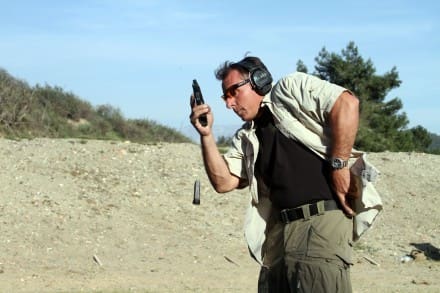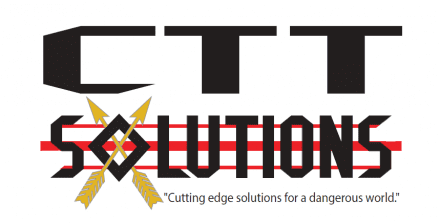One of the drills I do in pistol classes is to have shooters execute a Bullseye string shot all from the holster. I tell them to draw as fast as they can and then take the shot at the appropriate pace to achieve the desired level of precision. After the draw it truly is absolutely no different than a regular Bullseye string but there is a key training principle involved. The drill is designed with the two major steps intended to consciously contradict each other. When you draw rapidly the body is receiving a physical cue to go fast. Now after your body has received that very distinct subconscious cue, you must consciously tell yourself to slow down with the intended goal over time of the slowing process being subconscious as well based on what the sights dictate. Over time what I am patterning into the shooter is to detach the draw from the shot and thereby use the optimal speed for each specific task. I call this type of drill “changing gears” and more specifically it is a pace and precision adjustment exercise. I use this technique on multiple target drills with both carbine and pistol by having a series of speed shots followed by a precision shot. This is a staple of good training because the speed of the shot should be tied to nothing but the desired amount of precision required. Yesterday I was using an RSR Steel reduced IPSC and doing draw-shot-reload-shot drills at 50 yards for this very reason. It forces me to draw at my fastest pace, slow down and take a 50 yard shot, speed back up and reload as fast as I can and then slow down again and take another precision shot.
When you need a pistol for defense or sport, there is a time penalty for a slow and imprecise draw and that is separate from the shot requirements. “Changing gears” or pace and precision adjustment is a component mental skill and as such should be exercised and refined based on a drill structured to isolate and demonstrate it.
When I am limited in time here is my twenty minute 50 round course designed to integrate the conscious contradiction of a fast draw, reload or magazine exchange into a 50 round Bullseye course. I shoot it on either a B8C Bullseye target or preferably a 6” round steel plate.
All shots are fired from the holster alternating the start position from hands at sides to surrender position and all ending with the pistol returned to the holster.
40 draws (10 with transition to support hand), 50 precision shots (30 freestyle, 10 strong hand only 10 support hand only), 5 slide lock reloads, 5 magazine exchanges.
If you concentrate and make every shot a proper one that is a lot of work in 20 minutes!
– Mike Pannone
Mike Pannone retired from the Army’s premier assault force (1st SFOD-D) after an explosive breaching injury. A year after his retirement America was attacked on 9/11 and he returned to help serve his country as the head marksmanship instructor at the Federal Air Marshals training course and then moved to help stand up the FAMS Seattle field office. In 2003 he left the FAMS to serve as a PSD detail member and then a detail leader for the State Department during 2003 and 2004 in Baghdad and Tikrit.
In 2005 he served as a ground combat advisor of the Joint Counter IED Task Force and participated on combat operations with various units in Al Anbar province. Upon returning he gave IED awareness briefings to departing units and helped stand up a pre-Iraq surge rifle course with the Asymmetric Warfare Group as a lead instructor. With that experience as well as a career of special operations service in Marine Reconnaissance, Army Special Forces and JSOC to draw from he moved to the private sector teaching planning, leadership, marksmanship and tactics as well as authoring and co-authoring several books such as The M4 Handbook, AK Handbook and Tactical Pistol shooting. Mike also consults for several major rifle and accessory manufacturers to help them field the best possible equipment to the warfighter, law enforcement officer and upstanding civilian end user. He is considered a subject matter expert on the AR based Stoner platform in all its derivatives.
Gunfighter Moment is a weekly feature brought to you by Alias Training & Security Services. Each week Alias brings us a different Trainer and in turn they offer some words of wisdom.
Tags: Alias Training and Security Services, CTT Solutions, Mike Pannone




As always Mike well done – good writeup!!!
Excellent! Hit it out if the park!
Glad to see another instructor who values the benefits of competition shooting for combat performance. Visual Patience, it’s a thing.
What distance is the precision drill shot at? 25yds? It is also the same functionality you find in the excellent Dot Torture drill.
I do the 20 minute sequence on a B8C 25 yard rapid fire target replacement center at 25 yards. I am not really a fan of the dot drill because the short distance it is shot at lends itself to a level of emotional comfort that 25 yard shooting on a B8C does not afford. Another issue I have is that proportionately it is a much more forgiving target than what I use at the distance I shoot it. I have seen many shooters that can keep all their shots in the 2” dots at 3 to 5 yards but can’t keep 7 out of 10 in the 5.54” black (9 and 10 rings combined) of a B8 at 25. The 2″ dot at 5 yards would be the equivalent of a 10″ ten-ring at 25. The actual 10 ring on a B8 target is 3.36″. I also find that most shooters will “dirty up” the target with thrown shots and substantially degrade the benefit of the drill as designed. That’s just my 2 cents on the dot T drill and why I don’t use it, but if it gives you good proficiency benefit then drive on with it.
To paraphrase Somebody Famous (Wyatt Earp?) gunfight winners are those who can go slow the fastest. Another analogy is cornering a car; you have to be able to manage accelerator, steering wheel and brakes, at the right time, in the right amount, at the right point in and out of the corner.
OUTSTANDING!
That’s what I tell my self to draw quickly & then slow down to align sights & squeeze trigger.